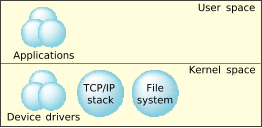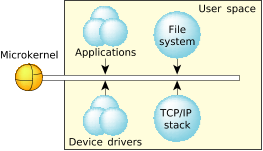Buzzwords often fall in and out of fashion. Vendors tend to enthusiastically apply the buzzwords of the day to their products, whether the terms actually fit or not.
The term “microkernel” has become fashionable. Although many new operating systems are said to be “microkernels” (or even “nanokernels”), the term may not mean very much without a clear definition.
Let's try to define the term. A microkernel OS is structured as a tiny kernel that provides the minimal services used by a team of optional cooperating processes, which in turn provide the higher-level OS functionality. The microkernel itself lacks filesystems and many other services normally expected of an OS; those services are provided by optional processes.
The real goal in designing a microkernel OS is not simply to “make it small.” A microkernel OS embodies a fundamental change in the approach to delivering OS functionality. Modularity is the key, size is but a side effect. To call any kernel a “microkernel” simply because it happens to be small would miss the point entirely.
Since the IPC services provided by the microkernel are used to “glue” the OS itself together, the performance and flexibility of those services govern the performance of the resulting OS. With the exception of those IPC services, a microkernel is roughly comparable to a realtime executive, both in terms of the services provided and in their realtime performance.
The microkernel differs from an executive in how the IPC services are used to extend the functionality of the kernel with additional, service-providing processes. Since the OS is implemented as a team of cooperating processes managed by the microkernel, user-written processes can serve both as applications and as processes that extend the underlying OS functionality for industry-specific applications. The OS itself becomes “open” and easily extensible. Moreover, user-written extensions to the OS won't affect the fundamental reliability of the core OS.
A difficulty for many realtime executives implementing the POSIX 1003.1 standard is that their runtime environment is typically a single-process, multiple-threaded model, with unprotected memory between threads. Such an environment is only a subset of the multi-process model that POSIX assumes; it cannot support the fork() function. In contrast, QNX Neutrino fully utilizes an MMU to deliver the complete POSIX process model in a protected environment.
As the following diagrams show, a true microkernel offers complete memory protection, not only for user applications, but also for OS components (device drivers, filesystems, etc.):
 Figure 1. Conventional executives offer no memory protection.
Figure 1. Conventional executives offer no memory protection. Figure 2. In a monolithic OS, system processes have no protection.
Figure 2. In a monolithic OS, system processes have no protection. Figure 3. A microkernel provides complete memory protection.
Figure 3. A microkernel provides complete memory protection.The first version of the QNX OS was shipped in 1981. With each successive product revision, we have applied the experience from previous product generations to the latest incarnation, our most capable, scalable OS to date. We believe that this time-tested experience is what enables the QNX Neutrino RTOS to deliver the functionality it does using the limited resources it consumes.